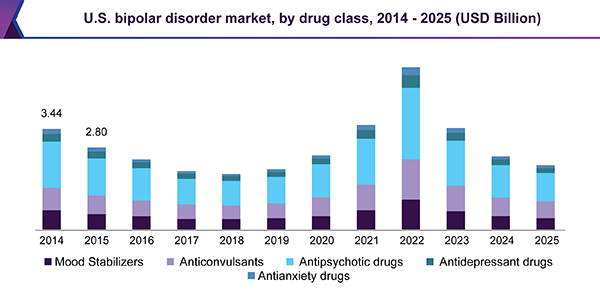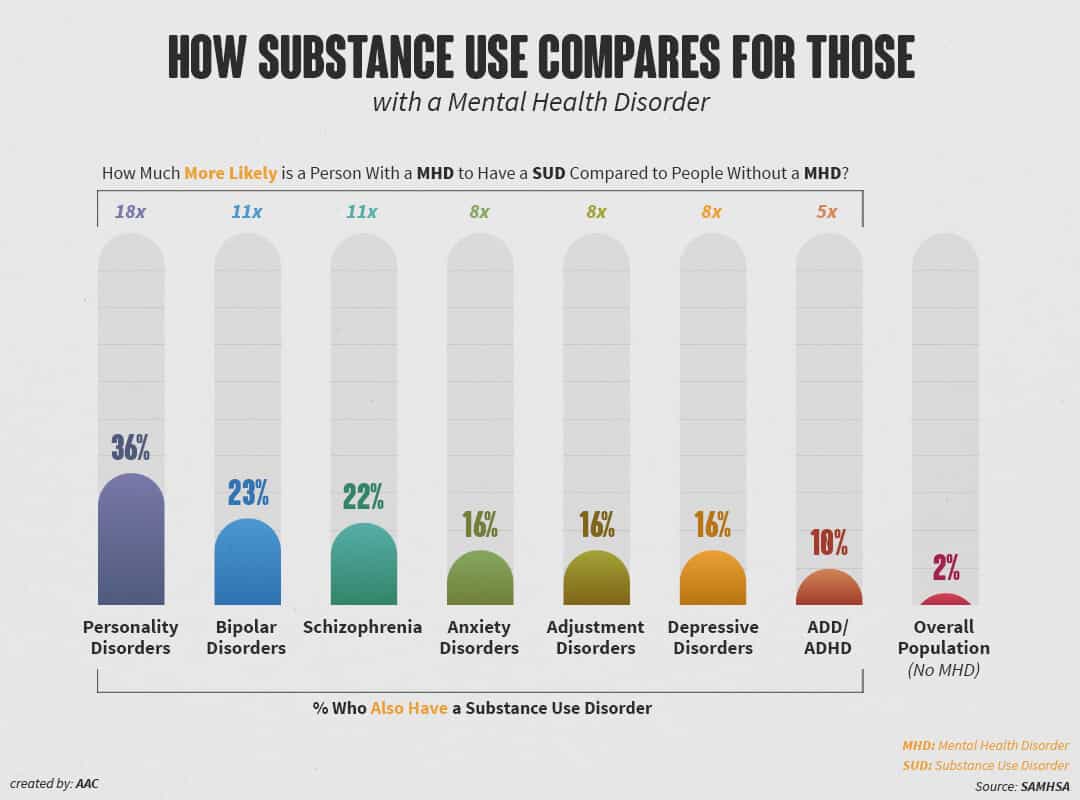Bipolar Disorder And Substance Abuse Statistics
The bipolar disorder suicide rate is about 11 percent. Population age 18 and older every year.

Five Year Prevalence Of Schizophrenia Upper Panel Bipolar Disorder Download Scientific Diagram
Although high rates of substance abuse have also been reported in bipolar patients the relationship between substance abuse and bipolar disorder has not been well characterized.

Bipolar disorder and substance abuse statistics. Symptoms can range from moderate to severe with addiction being the most severe form of SUDs. Call 855-466-7204 to speak. Substance abuse histories were obtained in 392 patients hospitalized for manic or mixed episodes of bipolar disorder and rates of current and lifetime abuse calculated.
CONNECT TO CARE Are You Seeking Treatment for Addiction. American Journal of Psychiatry. Between 5 and 15 percent of people with bipolar disorder will develop rapid cycling.
While 82 of the general population in the US. Alcohol misuse appears to be most common. 910 11 This Advisory provides behavioral health professionals with information on theof co.
Medications for bipolar disorder can calm mood shifts and bring equilibrium to a persons life. 2 Meta-analyses have indicated by averaging the variable findings of many studies cognitive deficits on some measures of sustained attention executive function. Bipolar disorder sometimes referred to as manic-depressive disorder is characterized by dramatic shifts in mood energy and activity levels that affect a persons ability to carry out day-to-day tasks.
Although researchers have proposed explanations for the strong association between alcoholism and bipolar disorder the exact relationship between these disorders is not well understood. Most individuals with bipolar disorder experience mood swings that range from extreme manic highs to severely depressed lows. For example in their study of 85 individuals with bipolar disorder and alcohol abuse Feinman and Dunner 1996 found that alcohol abuse occurred before the onset of bipolar disorder in 59 of the patients whereas 41 developed bipolar disorder first.
Bipolar Disorder and Substance Abuse. 2550 percent of people with bipolar disorder will attempt suicide. People with bipolar disorder have a 217 to 59 increased chance of being diagnosed with substance use disorder at least once in their life per SAMHSA.
One proposed explanation is that certain psychiatric disorders such as bipolar disorder may be risk factors for substance use. Lets review some of them now. The illness is characterized by patterns of mood.
People with bipolar disorder are 14 times more likely to abuse drugs and six times more likely to have alcohol dependence than the general population. -People diagnosed with bipolar disorder are 7x more like to develop substance abuse problems versus people who were not. Bipolar disorder much like substance abuse poses a significant risk to a persons physical and mental wellbeing and ultimately their life.
Indications for early intervention. -58 of people with bipolar disorder had a substance abuse issue at one point in their life. There are many statistics that highlight the link between substance abuse and bipolar disorder.
Substance abuse in people with bipolar disorder is also linked to higher rates of suicide. Dual diagnosis of bipolar and substance abuse is relatively common in the area of mental health and addiction. Substance abuse in first-episode bipolar I disorder.
A substance use disorder SUD is a mental disorder that affects a persons brain and behavior leading to a persons inability to control their use of substances such as legal or illegal drugs alcohol or medications. Between 40 and 70 of people with bipolar disorder have a history of substance use disorder. In this manuscript we focus on the role of stressors in the initiation of both bipolar disorder and substance abuse as well as their role in precipitating mood episode recurrence and addiction reinstatement.
Struggles with a substance use disorder the lifetime prevalence of SUDs in bipolar patients is close to 40 with alcohol cocaine opioids and cannabis as the most widely abused substances. Bipolar disorder is thought to be caused in part by an imbalance of the brains chemistry. Bipolar disorder is a mental illness that causes radical shifts in mood.
Similarly Winokur et al 1995 found that 47 of 64 patients began abusing substances after. Commonly misused drugs among people with bipolar disorder include alcohol and cocaine. Bipolar disorder affects approximately 57 million adult Americans or about 26 of the US.
Those with early onset bipolar disorder are also more prone to substance abuse disorders than those with adult onsets. These shifts in mood and energy levels are more severe than the normal ups and downs that are experienced by everyone. However treatment for bipolar disorder and SUDs is available and remission and recovery are possibleespecially with early intervention.
Addiction treatment medications stifle cravings and ease withdrawal symptoms. Bipolar disorder a serious psychiatric condition sometimes referred to as Manic Depression is aptly named due to the bipolar opposite of the extreme moods. Each phase of bipolar disorder is associated with an increased risk of substance abuse.
Once known as manic-depressive disorder bipolar disorder BPD presents itself in different forms and varies widely from person to person. According to the National Alliance on Mental Illness in America over 56 percent of people diagnosed with bipolar have a history of illicit drug abuse while 44 percent have abused or are dependent on alcohol. Medication can help people with bipolar disorder and addiction.
A current or past comorbid substance use disorder may lead to worse outcomes for bipolar disorder including more symptoms more suicide attempts longer episodes and lower quality of life. The type of addiction medication prescribed depends on the patients drug of abuse. In a survey of people with bipolar disorder substance abuse disorder was also diagnosed in 60 of.
Some estimates indicate that between 30 to more than 50 of people with bipolar disorder will also develop a substance use disorder. Baethge C Baldessarini R Khalsa H Hennen J Salvatore P Tohen M. While suicide is a risk of bipolar disorder professional treatment.
A few key bipolar disorder suicide risk statistics to take note of. Bipolar disorder and substance abuse are separate conditions but there is a strong association between them. Alcohol is the substance most commonly abused by people with bipolar disorder and in general.
Reviews have indicated that most individuals diagnosed with bipolar disorder but who are euthymic not experiencing major depression or mania do not show neuropsychological deficits on most tests. National Institute of Mental Health The median age of onset for bipolar disorder is 25 years National Institue of Mental Health although the illness can start in early childhood or as late as the 40s and. For bipolar patients co-occurring SUDs directly correlate with adverse effects on the trajectory of the.
This may contribute to the connection between being bipolar and drug addiction.

Bipolar Disorder Market Size Share Report 2018 2025

Namikauai Com The Heightened Risk Of Substance Use Associated With Mental Illness Namikauai Com
Average Annual Rate Of Increase In Prevalence Of Bipolar Disorder By Download Scientific Diagram

Pin On Mental Health Statistics And Resources

Supplemental Materials For Association Between Alcohol And Substance Use Disorders And All Cause And Cause Specific Mortality In Schizophrenia Bipolar Disorder And Unipolar Depression A Nationwide Prospective Register Based Study The Lancet

Posting Komentar untuk "Bipolar Disorder And Substance Abuse Statistics"